|
|
 |
|
Calanoida ( Order ) |
|
|
|
Clausocalanoidea ( Superfamily ) |
|
|
|
Aetideidae ( Family ) |
|
|
|
Chiridius ( Genus ) |
|
|
| |
Chiridius poppei Giesbrecht, 1892 (F,M) | |
| | | | | | | Ref.: | | | Giesbrecht, 1892 (p.224, 771, figs.F); Giesbrecht & Schmeil, 1898 (p.33, Rem.); A. Scott, 1909 (p.41, figs.F, Rem.); Wolfenden, 1911 (p.212, Rem.); Pesta, 1920 (p.509); Sars, 1925 (p.45, figs.F); Farran, 1926 (p.247); 1929 (p.208, 229, Rem.F); Rose, 1933 a (p.93, figs.F); Jespersen, 1934 (p.55); Rose, 1937 (p.163, Descr.M, figs.M); Tanaka, 1937 (p.254, figs.F); Lysholm & al., 1945 (p.13); Brodsky, 1950 (1967) (p.153, figs.F,M); Vervoort, 1952 c (n°44, p.3, figs.F); 1957 (p.55, Rem.F); Tanaka, 1957 a (p.50, figs.M, Rem.F,M); Grice, 1962 (p.192, figs.F); Vervoort, 1963 b (p.124, Rem.); Gaudy, 1963 (p.22); Chen & Zhang, 1965 (p.51, figs.F); Mazza, 1965 a (p.308, figs. juv.5); 1967 (p.114, 138, figs.juv., F,M); Owre & Foyo, 1967 (p.43, figs.F,M); Vives, 1967 (p.551, fig.M); Mazza, 1968 (p.531, figs.); Tanaka & Omori, 1970 (p.118); Razouls, 1972 (p.94, Annexe: p.42, figs.F,M); Park, 1975 b (p.280, figs.F,M); Bradford & Jillett, 1980 (p.24, figs.F,M, fig.73, distribution chart); Björnberg & al., 1981 (p.604, 632, figs.F); Chahsavar-Archad & Razouls, 1982 (p.28, fig.F); Markhaseva, 1996 (p.123, figs.F,M); Chihara & Murano, 1997 (p.684, Pl.34: F,M); Bradford-Grieve & al., 1999 (p.879, 920, figs.F,M); Vives & Shmeleva, 2007 (p.554, figs.F,M, Rem.) |  issued from : T. Park in Bull. Mar. Sci., 1975, 25 (2). [p.281, Fig.5]. Female (from Gulf of Mexico): a, b, habitus (dorsal, lateral, respectively); c, posterior part of metasome and urosome (right side); d, urosome (dorsal); e, P1; f, P2; g, lateral portion of third exopodal segment of second leg (anterior). P1-2: legs (anterior).
|
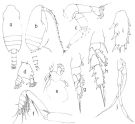 issued from : T. Park in Bull. Mar. Sci., 1975, 25 (2). [p.282, Fig.6] Male (from Gulf of Mexico): a, b, habitus (dorsal, lateral, respectively); c, A2; d, mandibular palp; e, Mx1; f, Mxp; g, P1; h, P2; i, third exopodal segment of second leg (anterior); j, P5. P1-2: legs (anterior), P5: fifth pair of legs (posterior).
|
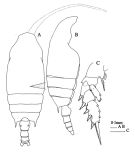 issued from : J.M. Bradford & J.B. Jillett in Mem. N.Z. Oceanogr. Inst., 86, 1980. [p.26, Fig.14]. Female: A, habitus (dorsal); B, idem (lateral right side); C, P2.
|
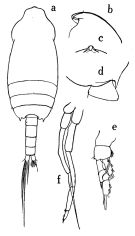 issued from : O. Tanaka in Publ. Seto Mar. Biol. Lab., 1957, VI (1). [p.51, Fig.31]. Male: a, habitus (dorsal); b, forehead (lateral); c, rostrum (anterior view); d, last thoracic segment (lateral); e, P1; f, P5. Nota: head and 1st thoracic segment fused, 4th and 5th fused. Rostrum short and one-pointed, rounded at the apex. No trace of median crest. Proportional lengths of urosomites and furca 20:26:20:18:2:14 = 100. Anal segment concealed beneath the foregoing. A1 (23-segmented) reaches back to distal and 2nd urosomal segment. Mx1 with 7 setae on outer lobe, 9 setae on exopod, 9 setae on endopod.
|
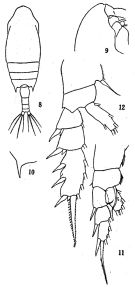 issued from: Q.-c Chen & S.-z. Zhang in Studia Marina Sinica, 1965, 7. [Pl.13, 8-12]. Female (from E China Sea): 8, habitus (dorsal); 9, forehead (lateral); 10, postero-lateral angles of last thoracic segment (lateral right side); 11, P1 (anterior).
|
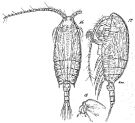 Issued from: G.O. Sars in Résult. Camp. Scient. Prince Albert I, 69, pls.1-127 (1924). [Pl.XV, figs. 16-18]. Female: 16, habitus (dorsal); 17, idem (lateral); 18, forehead (lateral).
|
 issued from : A. Scott in Siboga-Expedition, 1909, XIX a. [Plate XI, Figs.10-17]. Female (from Indonesia-Malaysia): 10, habitus (dorsal); 11, forehead (lateral; 12, last thoracic and genital segments (left side); 13, A1; 14, Mxp; 15, P1; 16, P2; 17, P4.
|
 issued from : M. Rose in Annls Inst. océanogr., Monaco, n. ser., 1937, XVII, 2. [p.164, Fig.6]. Male (from Alger Bay, Algeria): habitus (dorsal); Abd, urosome (dorsal); A1, A2, Md; Mx1 (as Mx); Mx2 (as Mxp1); P1 to P5. Nota: A1 21-segmented (but weakly separation between 8th-9th and 18th-19th segments. Rostrum absent.
|
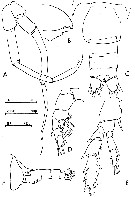 issued from : C. Razouls in Th. Doc. Etat Fac. Sc. Paris VI, 1972, Annexe. [Fig.42]. Female (from Banyuls, G. of Lion): B, forehead (lateral); C, urosome (dorsal); D, P1; E, P4; F, last metasomal segment and urosome (lateral). Male: A, P5.
|
 Issued from : W. Giesbrecht in Systematik und Faunistik der Pelagischen Copepoden des Golfes von Neapel und der angrenzenden Meeres-Abschnitte. - Fauna Flora Golf. Neapel, 1892. Atlas von 54 Tafeln. [Taf. 14 , Figs.14-18 ]. Female: 14, distal segments of A1 (ventral view); 15, Mxp (B1: posterior view, rest: posterior view, setae from Ri1 and 2 missing); 16, Mx2 (anterior view); 17, Md (anterior view); 18, basipods of P3 (posterior view). Ri = endopod; Re = exopod; L = lobe
|
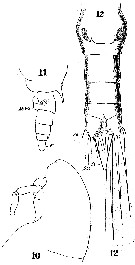 Issued from : W. Giesbrecht in Systematik und Faunistik der Pelagischen Copepoden des Golfes von Neapel und der angrenzenden Meeres-Abschnitte. - Fauna Flora Golf. Neapel, 1892. Atlas von 54 Tafeln. [Taf. 36 , Figs.10-12]. Female: 10, head (lateral); 11, last thoracic segment and urosome (lateral, left side); 12, urosome (ventral).
|
 Chiridius poppei Chiridius poppei Female: 1 - Exopod of Mx1 with 8 setae. Points of last thoracic segment reaching the midlength of the genital segment. 2 - Exopodal segment 3 of P2 without bulge and excavation between 2nd and 3rd external spines. Endopodal segment 2 of Md commonly with 9 setae. 3 - Exopodal segments 1 and 2 of P1 with external spines not reaching the base of next spine. Endopod of P2 1-segmented, exceeding exopodal segments 2-3 border.
|
 Chiridius poppei Chiridius poppei male: 1 - Points of last thoracic segment not longer than genital segment. 2 - Right P5 nearly as long as left. Endopodal segments 1 and 2 with external spines very short, not reaching the middle of the next segment.
|
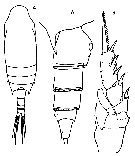 Issued from : O. Tanaka in Japanese J. Zool., 1937, VII, 13. [p.255, Fig.5]. Female (from coast of Heda, Japan): a, habitus (dorsal); b, abdomen (lateral); c, P2. Nota: Distal margin of the genital segment furnished with fine spinules; distal margin of the 2nd and 3rd abdominal segments with small serrated plates. Terminal spine of the exopod of P3 with 23 and P4 wiyj 22 teeth.
| | | | | Compl. Ref.: | | | Cleve, 1904 a (p.187); Pearson, 1906 (p.4: Rem.); Wilson, 1942 a (p.178); Massuti Alzamora, 1942 (p.110); Sewell, 1948 (p.347); Fagetti, 1962 (p.17); Gaudy, 1962 (p.93, Rem.: p.106); Giron-Reguer, 1963 (p.29); V.N. Greze, 1963 a (tabl.2); Gaudy, 1963 (p.22, Rem.); Unterüberbacher, 1964 (p.21); De Decker & Mombeck, 1964 (p.12); Pavlova, 1966 (p.43); Mazza, 1966 (p.70); 1967 (p.367); Furuhashi, 1966 a (p.295, vertical distribution in Kuroshio region, Table 9, 10); Grice & Hulsemann, 1967 (p.14); Dowidar & El-Maghraby, 1970 (p.267); Morris, 1970 (p.2300); Park, 1970 (p.475); Roe, 1972 (p.277, tabl.1, tabl.2); 1972 a (p.334); Apostolopoulou, 1972 (p.327, 346); Bainbridge, 1972 (p.61, Appendix Table III, occurrence); Björnberg, 1973 (p.323, 385); Vives & al., 1975 (p.42, tab.II, III); Vives, 1976 (p.104); Deevey & Brooks, 1977 (p.256, tab.2, Station "S"); Carter, 1977 (1978) (p.35); Dessier, 1979 (p.204); Vaissière & Séguin, 1980 (p.23, tab.2); Vives, 1982 (p.291); Kovalev & Schmeleva, 1982 (p.83); Brenning, 1983 (p.3, Rem.); Cummings, 1984 (p.163, Table 2); Roe, 1984 (p.356); Scotto di Carlo & al., 1984 (p.1043); Guangshan & Honglin, 1984 (p.118, tab.); Kinzer & Schulz, 1985 (tab.4); Brenning, 1985 a (p.28, Table 2); Lozano Soldevilla & al., 1988 (p.58); Cervantes-Duarte & Hernandez-Trujillo, 1989 (tab.3); Scotto di Carlo & al., 1991 (p.271); Hernandez-Trujillo, 1991 (1993) (tab.I); Seguin & al., 1993 (p.23); Shih & Young, 1995 (p.66); Hure & Krsinic, 1998 (p.101); Suarez-Morales & Gasca, 1998 a (p107); Moraitou-Apostolopoulou & al., 2000 (tab.I); Vukanic, 2003 (139, tab.1); Bradford-Grieve, 2003 (p.96, tab.1); Wang & Zuo, 2004 (p.1, Table 2, dominance, origin); Zuo & al., 2006 (p.162: tab.1); Isari & al., 2006 (p.241, tab.II); Gaard & al., 2008 (p.59, Table 1, N Mid-Atlantic Ridge); Raybaud & al., 2008 (p.1765, Table A1); Lan Y.C. & al., 2008 (p.61, Table 1, % vs stations); Licandro & Icardi, 2009 (p.17, Table 4); Williamson & McGowan, 2010 (p.273, Table 3, Pacific central gyres: N and S); Hernandez-Trujillo & al., 2010 (p.913, Table 2); Schnack-Schiel & al., 2010 (p.2064, Table 2: E Atlantic subtropical/tropical); Hidalgo & al., 2010 (p.2089, Table 2); Mazzocchi & Di Capua, 2010 (p.423); Medellin-Mora & Navas S., 2010 (p.265, Tab. 2); in CalCOFI regional list (MDO, Nov. 2013; M. Ohman, pers. comm.); Siokou & al., 2013 (p.1313, fig.4, 8, biomass, vertical distribution); Mazzocchi & al., 2014 (p.64, Table 5, abundance); Benedetti & al., 2016 (p.159, Table I, fig.1, functional characters); Benedetti & al., 2018 (p.1, Fig.2: ecological functional group) ; Belmonte, 2018 (p.273, Table I: Italian zones); Chaouadi & Hafferssas, 2018 (p.913, Table II: occurrence). | | | | NZ: | 17 | | |
|
Distribution map of Chiridius poppei by geographical zones
|
| | | | | | | | | | | | 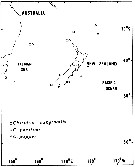 Issued from : J.M. Bradford & J.B. Jillett in New Zealand Ocean. Inst. Memoir, 86, 1980. [p.90-91, Fig.71]. Issued from : J.M. Bradford & J.B. Jillett in New Zealand Ocean. Inst. Memoir, 86, 1980. [p.90-91, Fig.71].
Distribution of several species of Chiridius in the Tasman Sea and around New Zealand.
Nota: Chiridius subgracilis ( = Chiridius molestus). |
| | | | Loc: | | | South Africa (E), Namibia, Congo, G. of Guinea (off Lagos), Atlant. (central equatorial), Cape Verde Is., Mauritania, off Morocco-Mauritania, Canary Is., SW Atlant., off Amazon, Caribbean Sea, Caribbean Colombia, G. of Mexico, Florida, Sargasso Sea, off Bermuda: Station "S" (32°10'N, 64°30'W), Azores, off Portugal, off W Cape Finisterre, Bay of Biscay, off W Scotland, S Strait of Davis (in Jespersen, 1934), Baie Ibéro-marocaine, Medit. (Alboran Sea, Habibas Is., Sidi fredj coast, Banyuls, G. of Lion, Marseille, Ligurian Sea, Tyrrhenian Sea, Strait of Messina, Adriatic Sea, Ionian Sea, Aegean Sea, Lebanon Basin, Alexandria), Natal, Indian, Indonesia-Malaysia, China Seas (Yellow Sea, East China Sea, South China Sea), Taiwan (N: Mienhua Canyon), Japan, off Hokkaido SE, Suruga Bay, Mariannes Trench, Pacif. (central subtropical), Pacific (central gyres: N and S), W Baja California (Bahia Magdalena), Pacif. (W equatorial), off New Zeland, SE North Island, Chile (N-S).
Type locality: Mediterranean Sea. | | | | N: | 107 | | | | Lg.: | | | (1) F: 2 ; (5) F: 1,8; (10) F: 1,9; (14) F: 2,2; (22) F: 2,04-1,8; (35) F: 2-1,92; (37) F: 2,2-1,59; M: 1,58-1,5; (38) F: 1,92; (39) F: 1,87-1,83; M: 1,52; (46) F: 1,8; (101) F: 1,83-1,59; (113) F: 2,26-1,76; M: 2,13-1,65; (128) F: 1,87-1,83; (197) F: 1,84-1,76; M: 1,58-1,5; (199) F: 2,36-1,75; M: 1,9-1,75; (201) F: 1,6-1,9; (207) F: 2,12-1,84; M: 1,68-1,60; (228) M: 1,7; (244) F: 1,9; (260) F: 1,96-1,84; (290) F: 1,87; (432) F: 2,45-2; (449) F: 1,8; (866) F: 1,59-2,26; M: 1,52-2,13; (1109) F: 1,82-1,92; {F: 1,59-2,45; M: 1,50-2,13}
The mean female size is 1.913 mm (n = 39; SD = 2029), and the mean male size is 1.696 mm (n = 14; SD = 0.2146). The size ratio (male : female) is approximately 0.88. | | | | Rem.: | epi- bathypelagic. Sargasso Sea: 500-1500 m. 0-217 m at Station T-1 (Tori Is, E Japan). Abundant almost exclusively in the north Aegean Sea deeper than 300 m (Siokou & al., 2013).
For Rose (1937, p.165) the male resembles C. poppei female by the appendage structures, with dte usual sexual differences between sex. It is probably the male of C. poppei.
After Markhaseva (1996, p.123) the exopod female of P2 is 3-segmented (in original material the separation between segments 1 and 2 incomplete) and endopod 1-segmented (with traces of separation).
R. Stephen: Data sheets of NIO, Kochi, India (on line).
After Benedetti & al. (2018, p.1, Fig.2) this species belonging to the functional group 4 corresponding to small filter feeding herbivorous and mixed feeding omnivorous (mostly broadcasters). | | | Last update : 02/04/2020 | |
|
|
 Any use of this site for a publication will be mentioned with the following reference : Any use of this site for a publication will be mentioned with the following reference :
Razouls C., Desreumaux N., Kouwenberg J. and de Bovée F., 2005-2025. - Biodiversity of Marine Planktonic Copepods (morphology, geographical distribution and biological data). Sorbonne University, CNRS. Available at http://copepodes.obs-banyuls.fr/en [Accessed August 17, 2025] © copyright 2005-2025 Sorbonne University, CNRS
|
|
 |
 |
















